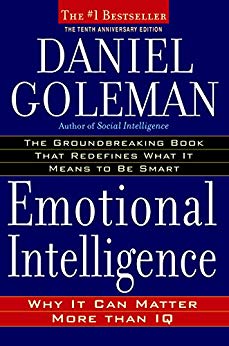

This article is an excerpt from the Shortform summary of "Emotional Intelligence" by Daniel Goleman. Shortform has the world's best summaries of books you should be reading.
Like this article? Sign up for a free trial here .
Have you ever looked back on an emotional response you had and thought, “I don’t know what came over me!” This is what Goleman would refer to as a limbic or emotional hijacking, where the emotional center of your brain takes over without notice. We usually associate it with negative emotions, but it can be positive, too–if you’ve ever laughed uncontrollably and felt like you couldn’t stop, that’s a hijacking.
Research shows that we unconsciously understand what something is and make a value judgement as to whether it’s a good or bad thing in the first few milliseconds of perceiving it.
When people who are afraid of snakes are shown photos of snakes, their skin breaks out in sweat even if they say they aren’t afraid. Their skin still does this even if the photos are flashed so quickly they don’t register they’ve seen it.
This has to do with how the brain is set up, and the balance between the epicenters of our two minds: the amygdala (the center of emotions) and the neocortex (the center of reason).
The Amygdala
There are two amygdalas on either side of the brainstem, at the base of the limbic system. The amygdala is the command center of our emotions, responsible for interpreting emotional signals and for storing our emotional memory.
The human amygdala is much larger than the amygdala in our closest relatives, nonhuman primates. Animals and humans who’ve suffered damage to or the severing of their amygdalas completely lose the ability to feel emotion or understand emotion in others.
The amygdala is constantly on the lookout for danger or dislike–for negative emotional content. If it perceives a threat to our emotional health or physical safety, it reacts instantaneously and sends a crisis message out to the entire brain – causing an amygdala hijacking.
The brain is set up so that sensory information from the eye or ear goes first to the amygdala and then to the neocortex, meaning the amygdala can respond while the neocortex is putting the information through several levels of consideration. And since the amygdala is also the center of emotional memory, this is why traumatic emotional responses can stick with us even when we aren’t aware we have them. The more intense the signals sent to the amygdala, the stronger the amygdala imprints the memory. (Shortform note: We discuss trauma more in-depth in the next section.)
Amygdala Hijackings and Childhood
Once the amygdala has an emotional memory of a certain situation, any new situation that resembles the old one will trigger the amygdala’s stress response, whether the situations are ultimately similar or not. For instance, this is why many adults who got bit by a dog when they were kids still fear dogs: though it’s not the same dog and though the person might not be in any danger of getting bit, the amygdala triggers the same emotional response to the sight of any remotely similar dog. Cue the emotional hijacking.
The amygdala is already close to being fully formed at birth, while our neocortex is not. This means our rational mind has more time to change and develop, but our emotional mind is solidified at a very young age: many of our strongest emotional memories occur in the first few years of our lives when we have not developed language or logic to understand them or process them.
So our childhood experiences deeply influence our emotional wellbeing as adults, and can cause amygdala hijackings today well after the danger has passed.
Though many people believe that infants or children won’t remember what happened, this is not true: though they might not be able to recall exactly what happened, they will always carry with them how their experiences made them feel. Our childhood emotional experiences and how our parents respond to them lay the blueprint for how we respond to emotional experiences as adults–and the more traumatic the experience, such as physical abuse or emotional neglect, the more they affect our ability to be emotionally healthy adults.
The Neocortex
There’s a moderator for the amygdala at the other end of the neocortex, in the prefrontal lobe just behind the forehead. This area regulates emotional responses, quells feelings in order to think more rationally about the situation at hand, and recalls the appropriate response if the amygdala analyzes the situation wrong and causes an emotional hijacking.
- (Shortform note: Like a surprise party–when the lights flip on and everyone shouts, the person being surprised is under the sway of their amygdala–they’re afraid. But then the prefrontal lobe assesses the situation and brings up the appropriate response: happiness at seeing their loved ones gathered in celebration. If the prefrontal lobe didn’t take control, the surprised person would probably take off out the door or start fighting the party guests.)
- This is also why medical science believed that lobotomies were the cure-all for many mental conditions: severing the prefrontal lobe from the rest of the brain cuts off a patient’s emotional response, and relieves any mental distress. However, the cost of this “solution” was that patients’ emotional lives disappeared entirely, since the emotional circuitry had been destroyed.
The prefrontal cortex also contains our working memory–the facts we need to complete a certain task or solve a certain problem. However, due to the connection between the amygdala and the prefrontal cortex, if our amygdala is sending out signals of strong emotion, it creates something similar to static in our prefrontal cortex, and it interferes with our working memory and ability to complete tasks.
The connection between the amygdala and the prefrontal cortex also explains why prolonged emotional distress has devastating effects on a child’s ability to learn (emotional overload and amygdala hijackings severely hinders their working memory needed to learn and perform well in school).
———End of Preview———

Like what you just read? Read the rest of the world's best summary of Daniel Coleman's "Emotional Intelligence: Why It Can Matter More than IQ" at Shortform . Learn the book's critical concepts in 20 minutes or less .
Here's what you'll find in our full Emotional Intelligence summary :
- What are emotions? Why do we have them?
- What is emotional intelligence? Why is it important?
- How do you manage your own emotions? Anger, anxiety, and sadness?
- How can you approach your relationships with more emotional intelligence?
- How can you teach your children emotional intelligence?
- How can emotional intelligence boost your career?






